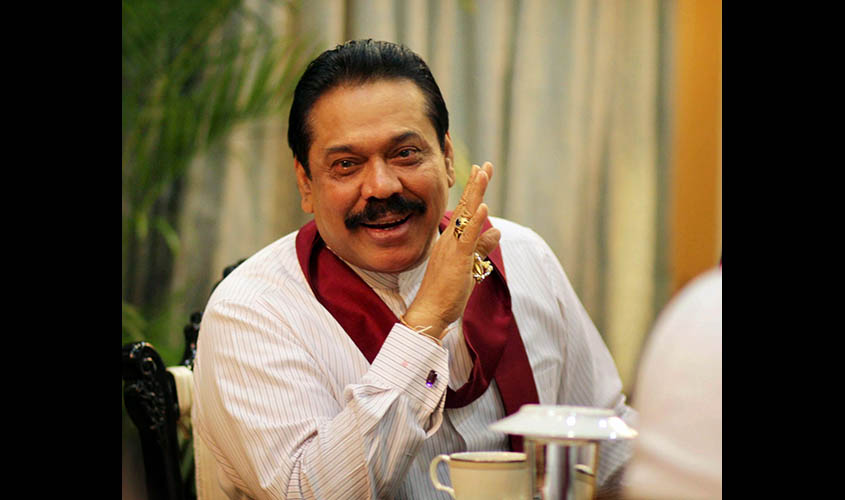An individual with a deep knowledge and love of India and its history and culture, Rajapaksa’s visit will renew his contact with the many friends he has in Delhi.
COLOMBO: In 2009, the then President of Sri Lanka, Mahinda Rajapaksa, supervised the elimination of the Liberation Tigers of Tamil Eelam (LTTE) from their last remaining pocket in the jungles of the Wanni. Several European countries had joined the United States in asking him to cease operations against the LTTE and its cornered supremo, Velupillai Prabhakaran, whose Christian faith could not prevent him from inflicting often terminal pain on those he saw as obstacles to his objective of being the ruler of an independent homeland. The Tamil Eelam of Prabhakaran would initially comprise the eastern and southern parts of Sri Lanka, but subsequently spread to all of Tamil Nadu and parts of neighbouring states, eventually reaching a size bigger than Malaysia. His long-time part-mentor Anton Balasingham and his Australian spouse were instrumental in ensuring that NGOs and even governments across Europe assisted the LTTE, whose modules found safe havens in several European as well as South-East Asian countries, not to mention India, whose agencies were generous for years in providing assistance to Prabhakaran. Subsequently, Prime Minister Rajiv Gandhi lost his patience and sent the Army into Sri Lanka, which would have completed a decade earlier the mission accomplished in 2009 by President Rajapaksa, which was the elimination of the LTTE. However, once the India-phobic Ranasinghe Premadasa took over from J.R. Jayewardene as the Head of State and Government of Sri Lanka, he joined hands with the LTTE and managed to secure the withdrawal of the Indian Peacekeeping Force (IPKF) once V.P. Singh took over as Prime Minister from Rajiv Gandhi. Soon after, Prabhakaran “repaid” Premadasa for the favour by killing him, thereby creating a cautionary tale to those credulous enough to believe that a terrorist can ever change his or her core character through the granting of largesse, the way the National Security Council in Washington believes that the Taliban will someday morph into the Afghan equivalent of an English county cricket team.
The LTTE was a far deadlier organisation than the Taliban ever was, but which has yet succeeded in defeating the combined armies of several NATO powers in Afghanistan, mainly as a consequence of the self-defeating tactics followed by an alliance that is visibly in need of a comprehensive reset. However, both Presidents George W. Bush and Barack H. Obama failed to eliminate the Taliban, and now the National Security Council of their successor is once more reaching for that consistently failed formula, “talks with the Taliban” to “detach the moderates from the fanatics” in that collective of extremist gangs. Mahinda Rajapaksa, with a military considerably smaller than that of the US or the UK or even Poland, defeated the LTTE. Small wonder that he is disliked in both Washington as well as London for having shown up the incompetence of those who claim they are still the dominant military force in global geopolitics. In this task, Rajapaksa was assisted by younger brother Gotabhaya, who was Defence Secretary during the period when the war with the LTTE was being waged to a successful conclusion. However, this victory did not prevent Rajapaksa from being defeated in the 2015 polls, largely because the economic benefits that the Sri Lankan population were promised after the elimination of the LTTE failed to materialise to the extent expected. Many voters were unwilling to wait a few more years for better days. However, visitors to Sri Lanka cannot fail to notice a revival of popularity for the former President, who is sought to be prevented from running again for the Presidency through laws passed for the purpose by the successor government. A way out would be for a respected loyalist such as G.L. Peiris to be elected the President of Sri Lanka in 2019, with Mahinda Rajapaksa taking over as Prime Minister once the polls for Parliament got concluded a few months later. This would be a repeat of what the world has witnessed with Vladimir Putin and Dmitry Medvedev, and in such a situation, the reins of government would be in the hands of the Prime Minister, as is usually the case in a parliamentary democracy. Prime Minister Rajapaksa could then assign important tasks to known high achievers such as Gotabhaya, who could take charge of promoting economic development in Sri Lanka, another war that must be won by this beautiful land.
President Rajapaksa’s 2015 defeat—just six years after the defeat of the LTTE—has been ascribed by some of his followers to a conspiracy masterminded by the US and India, but an alternative explanation may vest in the impatience of the youth voter hungry for economic opportunity and change. Rajiv Gandhi did himself no favour by lowering the voting age to 18, a group that enthusiastically backed Narendra Modi in 2014 on the promise of jobs. 2019 will show whether the youth of India are ready to give the PM time till 2022 to more visibly fulfil the promises made in 2014, or will vote for change. Some 20 months after his defeat, confronted with the intricacies of governance by an uneasy coalition, many Sri Lankan voters felt regretful that Mahinda Rajapaksa was no longer in charge, especially when most of the projects that have proliferated in the country were begun during his tenure. However, as matters stand, it seems clear that the former President will succeed next year-end in getting back to power. An individual with a deep knowledge and love

